Techniques and Trends in Ring Size Alteration


Intro
When it comes to jewelry, few pieces hold as much sentimental value as rings. Whether it's an engagement ring, a family heirloom, or a simple token of affection, rings connect us to significant moments in our lives. They are often more than just decorative items; they're cherished symbols. However, as life changes, so too might the need to resize a ring. This process—ring size alteration—is integral to maintaining the fit and comfort of these precious tokens. In this article, we will explore the techniques jewelers employ to resize rings, the various challenges they encounter, and the current trends that influence consumer decisions regarding ring size alteration.
Gemstone Overview
Definition of Gemstones
Gemstones are naturally occurring minerals or organic materials that are typically cut and polished to create jewelry. These precious and semi-precious stones are valued for their beauty, durability, and rarity. They come in a wide range of colors, shapes, and sizes, each bringing its own unique aesthetic to a piece of jewelry. Common examples of gemstones include diamonds, rubies, and sapphires, but the world is rich with less familiar stones too, like tanzanite or garnet.
Classification of Gemstones
Gemstones can be classified into several categories based on their properties and characteristics:
- Precious Gemstones: Generally include diamonds, rubies, sapphires, and emeralds, known for their high value and exceptional qualities.
- Semi-Precious Gemstones: These include a broader range of stones such as amethyst, turquoise, and topaz, which, while beautiful, are typically less costly than precious stones.
- Organic Gemstones: Includes materials like amber and pearl, which are derived from living organisms.
Each classification highlights the distinct attributes of these stones, and while some might be more sought after than others, every gemstone holds a story of its own.
Historical Significance
Origins of Gemstone Use
The allure of gemstones is not a modern phenomenon. Historically, these beautiful stones have captivated mankind for thousands of years. The use of gemstones can be traced back to ancient civilizations, where they served various purposes, from adornment to protection against harm. It is fascinating how cultures throughout history have ascribed different meanings and powers to different stones, with rubies believed to inspire love and sapphires associated with wisdom.
Cultural Insights: Gemstones in Ancient Civilizations
In ancient Egypt, gemstones were often embedded into the tombs of pharaohs, believed to provide protection in the afterlife. The Egyptians valued lapis lazuli for its deep blue color and thought it brought cosmic protection. Another example can be found in ancient India, where diamonds were seen as symbols of strength and invincibility, often worn by warriors during battle.
"Gemstones have transcended mere decoration; they encapsulate cultural significance that reveals the values and beliefs of societies across centuries."
Today, the significance of gemstones continues to evolve, with jewelry not only serving as an expression of personal style but also as reflections of deeper meanings and connections to history.
Understanding the roots of gemstone use enriches our appreciation of ring size alteration; after all, resizing a ring can impact not just the physical fit, but the emotional and cultural narratives that accompany these treasured pieces.
Prologue to Ring Size Alteration
In the intricate world of jewelry making, resizing rings is a fascinating topic that intertwines art, science, and personal significance. Rings often hold emotional stories, symbolizing relationships, achievements, or personal milestones. As such, understanding the process and considerations around ring size alteration is essential not only for jewelers but also for anyone who cherishes these adornments. The act of resizing can offer a new lease on life for a cherished heirloom or a gift that no longer fits comfortably.
This article will explore various aspects of ring size alteration, providing insight into techniques, challenges, and trends. The importance lies not just in the act itself but in the craftsmanship and care that go into ensuring that the ring retains its integrity while adapting to fit the wearer.
Defining Ring Size Alteration
Ring size alteration is the process of adjusting the circumference of a ring to make it fit better for the wearer. This can involve either shrinking or stretching a ring, depending on whether the ring is too loose or too tight. Jewelers employ various techniques in this process, generally guided by the specific material of the ring and any design intricacies it may have.
The process is not as simple as it may sound; jewelers need to consider factors like the type of metal used, any gemstones set in the band, and if there are decorative features that could be compromised during resizing. Without careful attention to these details, a ring could lose its structural integrity or aesthetic appeal.
Historical Context
The practice of resizing rings is not something that popped up overnight. Historically, rings have been worn since antiquity, serving as symbols of power, love, or status. In ancient Rome, for instance, it was customary for individuals to wear rings that symbolized their social standing. Over the centuries, as styles and personal tastes evolved, so too did the need for resizing.
The art of resizing was mostly localized to skilled craftsmen—goldsmiths and jewelers, who learned their trade through apprenticeships. In many societies, the ability to resize a ring spoke volumes about the jeweler's skill. In some cultures, rings were even seen as talismans or objects of protection, making their fit all that more crucial.
With the rise of modern tools and technology, resizing techniques have become more precise. Yet, the history underscores that the significance of a ring extends beyond its physical form; it embodies connections, memories, and milestones that often shift with time, just like the ring itself.
"Rings are not just ornaments; they are storytellers that narrate an individual’s journey."
In summary, understanding the significance, methods, and historical context of ring size alteration enriches our appreciation for this meticulous craft. As we delve deeper into the techniques, materials, and challenges faced by jewelers today, recognizing the importance of a well-fitted ring becomes all the more evident, allowing wearers to fully embrace the deep connections their rings represent.
The Techniques of Ring Size Alteration
The art of ring size alteration is more than just a functional task; it encompasses a blend of craftsmanship, precision, and an understanding of human emotion. Rings often carry deep sentimental value. A properly resized ring can restore its significance and ensure a comfortable fit. Therefore, grasping the techniques involved is vital for jewelers and customers alike.
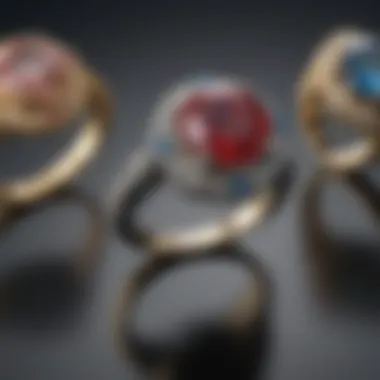
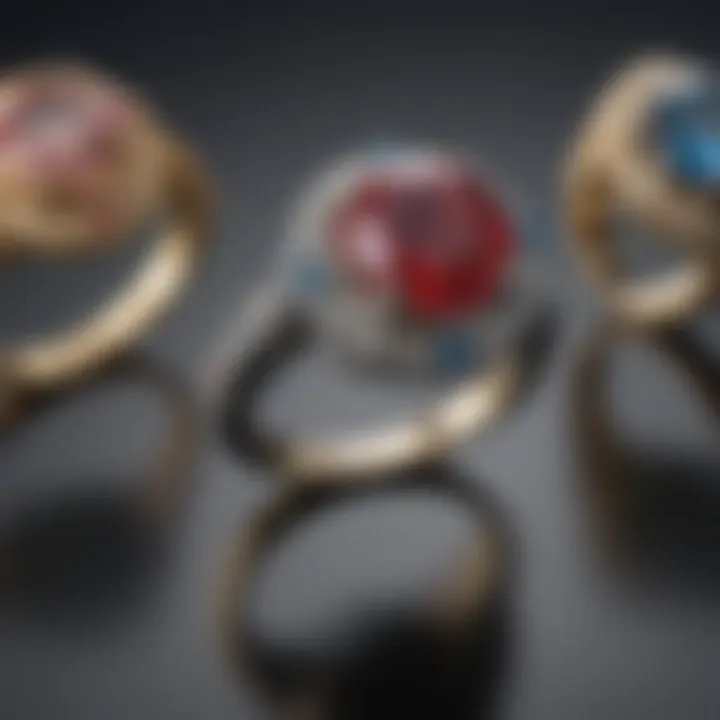
This section delves into the minutia of three primary techniques for resizing rings: stretching, shrinking, and adding or removing material. Each method holds its own merits, challenges, and considerations, and understanding these will empower one to choose the most appropriate option.
Stretching a Ring
Stretching a ring is frequently the first approach when there's a need for enlargement. The process tends to be executed with a specialized tool called a ring stretcher, which gradually expands the band by applying even pressure. The key here is not just to make the ring larger, but to do so without compromising its structural integrity.
Considerations for this method include:
- Material Type: Soft metals like gold or silver stretch well, while harder alloys may present challenges.
- Design Features: Intricate designs or stones set deeply can be adversely affected if stretching isn’t managed skillfully.
- Comfort: Resizing must not only focus on size but also ensure the ring feels right on the finger, accounting for any variations in body temperature or swelling.
Overall, stretching can be a simple yet effective method when employed correctly, although the jeweler must have both proficiency and experience.
Shrinking a Ring
On the flip side, shrinking a ring might seem less straightforward, yet it serves a purpose for those needing a tighter fit. Jewelers typically use a technique that involves cutting the band and then soldering it back together. Precision is paramount here, as the join must be meticulous and polished to maintain aesthetic consistency.
Points to consider include:
- Potential for Damage: Some materials, like certain gemstones, can be sensitive to the heat generated during soldering.
- Preservation of Design: Ensuring that the overall design isn’t distorted post-resize is crucial, especially for detailed patterns or engravings.
- Ring Metal: Different metals react uniquely to heat, affecting shrinkage results and transitions.
In this technique, careful planning can yield impressive results, allowing a ring to return to its ideal size without losing its charm.
Adding or Removing Material
In some situations, simply stretching or shrinking won't cut it. Jewelers may find it necessary to add or remove material altogether, especially when size alterations fall outside of typical ranges. For example, a ring may have significant weight due to a thick band or a dense setting.
Here, the sizing can go in two directions:
- Adding Material: Jewelers may create a seamless look by adding extra metal. They can take continuous metal from another band or use solder to blend in new metal, ensuring a natural appearance.
- Removing Material: By cutting out excess material, the ring can become smaller without sacrificing its design integrity. However, care must be taken to assure that the cut isn’t visible, maintaining the overall aesthetic.
This technique can open avenues for creativity but requires skilled workmanship. Jewelers must balance functionality with artistry when applying this method.
"The techniques of ring resizing don’t merely alter dimensions; they liberate the emotional resonance embedded in the jewel itself."
Materials Used in Resizing
When we dive deep into the world of jewelry resizing, understanding the materials involved is like having a compass in unknown waters. The right choice of materials directly impacts the quality and durability of the altered ring. Jewelers must navigate a complex landscape of various metals and gemstones while ensuring that the final product meets the aesthetic and functional desires of the wearer.
Metals Considerations
Resizing rings often involves working with different metals, each having unique properties. Commonly used metals in jewelry include gold, silver, platinum, and palladium. Each of these materials requires specialized approaches to alteration due to their distinct physical and chemical characteristics.
- Gold: This precious metal is particularly flexible, allowing jewelers to stretch rings relatively easily. However, gold can also be soft—especially in its higher karats—making it vulnerable to scratches. Jewelers often consider the alloy composition to determine the best resizing approach.
- Silver: Jewelry made of silver is quite malleable, which makes it easier to resize. However, sterling silver, which comprises 92.5% silver and 7.5% other metals (usually copper), can tarnish over time. Understanding how the tarnishing process affects the resizing is critical for a jeweler.
- Platinum: As a denser and stronger metal, platinum presents a real challenge when resizing. Its toughness means that specialized tools must be employed, often making the resizing process more labor-intensive compared to gold or silver.
- Palladium: Similar to platinum but lighter, palladium also offers a unique blend of strength and ease of handling for jewelers. This metal resists tarnish and can be resized without significant worry over future corrosion.
Each choice has its ups and downs, and jewelers need to weigh these considerations before attempting any resizing. It’s not just about making the ring fit; it’s about preserving the integrity and beauty of the piece.
Gemstone Stability During Resizing
Now, we can’t forget about the gemstones embedded in these rings. Aesthetics matter, but so does the stability of the stone during the resizing process. Some gemstones are vulnerable to heat or pressure, which can lead to cracks or even breakage.
When resizing rings that feature gemstones, jewelers often implement measures to protect these prized possessions. There are a few key points to ponder:
- Heat Sensitivity: Many gemstones, such as opals or emeralds, have a lower heat tolerance. Jewelers periodically remove stones before making size modifications to avoid exposing them to high temperatures.
- Clarity and Size Alterations: Altering the size of a ring can inadvertently affect the positioning of the gemstone. This necessitates a careful arrangement to ensure the stone remains secure and properly aligned.
- Stone Type: Factors such as hardness or clarity of the stone matter enormously. A sapphire might withstand resizing far better than an aquamarine, primarily due to its durability.
Protecting the gemstones is not just a practice; it’s an art, requiring careful planning and skill.
In summary, the materials used in ring resizing are not mere details—they’re foundational elements that dictate the success of the process. Jewelers need to be aware of the unique characteristics of metals and gemstones to navigate resizing's challenges effectively. Whether considering the flexibility of gold or the stability of a diamond, each choice intertwines craftsmanship with the emotional value often tied to rings.
Challenges in Altering Ring Sizes
Altering ring sizes is more than just a mechanical adjustment. It requires a thorough understanding of both the material and emotional elements involved. Whether resizing a treasured heirloom or a modern piece, various challenges arise that can significantly impact both the quality of the alteration and the satisfaction of the customer. Jewelers must navigate these challenges with precision and creativity to achieve the desired outcome without compromising the ring's integrity or aesthetics.
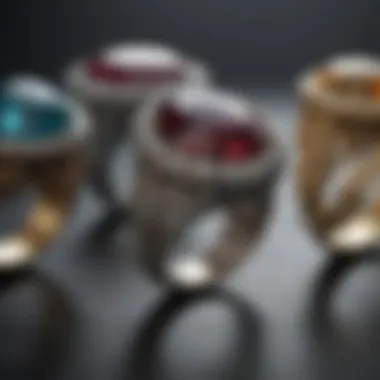

Structural Integrity
One of the foremost challenges jewelers encounter during ring resizing is maintaining the structural integrity of the piece. This challenge is particularly evident when dealing with intricate designs or unique materials. For instance, rings made from softer metals, like gold, might stretch easily but can also distort their original shape if not handled correctly. Conversely, harder metals like platinum may require specialized techniques that could lead to cracking if done hastily.
Moreover, gemstones set in rings are another critical consideration. The resizing process can create stress on the prongs or bezels holding the stones. If the stones are not properly secured or if prongs are stretched too thin, there's a risk of losing the gemstone altogether.
It's vital for jewelers to assess the ring's design before opting for any resizing technique. Factors such as the thickness of the band, the setting type, and even the stone's flanking features weigh heavily on the resizing method chosen. Using advanced technologies or tools, jewelers can analyze the strain points on the ring, allowing them to resize while safeguarding its overall structure.
"The art of resizing lies in understanding the balance between functionality and beauty. A jeweler must consider how the alteration impacts not just the size, but the soul of the piece."
Impact on Design and Aesthetics
Once the structural integrity is assessed, the impact on design and aesthetics becomes the next hurdle. Resizing a ring often entails alterations that can inadvertently affect its original visual appeal. For example, a simple widening of a band can change its contour, affecting how light reflects off its surface. A ring with a detailed engraving or intricate filigree may lose its fine details if too much material is added or removed.
When reshaping a ring, the challenge lies in preserving the unique attributes that make the piece special. Jewelers might also face a dilemma when the design involves multiple layers or contrasting materials, which can complicate the resizing process.
Additionally, how a resized ring looks on a finger can be a touchy subject. A ring’s proportion can shift dramatically, altering its relationship with the wearer’s hand. Rings that may have once fit snugly on the finger might appear awkwardly spaced after resizing. Hence, maintaining a ring's aesthetic while modifying its size is not merely a technical task but an art form that takes considerable skill and understanding.
Considering these challenges not only improves the quality of the resizing work but also helps nurture a lasting relationship between jewelers and customers, where expectations align and customers can find the beauty intact in the resized piece.
The Psychological Aspects of Ring Size Decisions
When it comes to rings, particularly those linked to significant life events like engagements or anniversaries, size matters — but not just in the physical sense. The psychological dimensions of ring size decisions stretch far beyond mere measurement. These decisions intertwine emotional value and personal experiences, often dictating how individuals perceive both the jewelry and themselves. Understanding these intricacies offers a clearer view of how rings possess deeper meanings than what initially meets the eye, especially for gemstone enthusiasts and collectors who appreciate not just the aesthetics but also the stories behind the pieces.
Emotional Significance of Rings
Rings often symbolize love, commitment, and monumental life events. The emotional load they carry is similar to a slow cooker full of flavors — a mix that takes time to develop. For many, a ring is not just an accessory; it is a tangible reminder of promises made and treasured moments. This significance makes resizing a ring a multi-layered challenge. If a ring no longer fits, it can feel as though the very connection to those memories is also at risk. Individual feelings can range from anxiety over altering such a sentimental token to outright distress if the ring needs resizing or maintenance. For instance, a woman receiving her grandmother's engagement ring might experience conflicting feelings over its fitting — she wishes to wear it but is cautious about changing its form.
"For many, rings represent more than metal and stones – they hold the whispers of cherished memories and unbreakable bonds."
Rings can also signify milestones — think of graduation, birthdays, or anniversaries. Each milestone becomes a landmark on a life map, and a ring that fits just right plays its part in that journey. Alteration based on changing sizes due to life events — like pregnancy or weight fluctuations — may feel like reinterpreting these milestones. The sharing of these significant moments intertwines ring sizing choices with personal narratives.
Personal Identity and Size Choices
Personal identity plays a noteworthy role in how individuals approach ring resizing. The size of a ring can essentially reflect one’s identity, self-image, and life stage. Consider a person who has always worn a size 7 ring only to find their size has changed due to health or lifestyle shifts. The decision to resize becomes more than practical — it is an assertion of who they are now as opposed to who they used to be. It's akin to getting a new pair of shoes that doesn't fit the old persona, but rather fits the future one.
The symbolism of ring size doesn't exist in a vacuum. In different cultures, larger rings may symbolize wealth or status, while smaller styles may reflect a more minimalist approach. Regardless of the actual size, what matters is how it aligns with personal beliefs and feelings. A size that feels comfortable may also embody self-acceptance, signaling a content state of being. Conversely, if a person feels uncomfortable in a larger or oversized ring, it could reflect insecurities related to their self-worth.
Cultural Significance of Ring Sizes
The significance of ring sizes transcends mere aesthetics, weaving deeply into the fabric of various cultures worldwide. Rings serve as symbols of commitment, identity, and even social status, carrying meaning far beyond their physical properties. Understanding these nuances can enlighten both jewelers and customers alike, as they navigate the complex landscape of ring size alteration. When one contemplates resizing a ring, it’s crucial to remain mindful of these cultural underpinnings, as they shape perceptions and personal attachments.
Cultural Variations in Ring Sizes
Rings, particularly those that denote commitment, can differ dramatically in size across cultures. For instance, in Western traditions, engagement and wedding rings are typically worn on the fourth finger of the left hand. In contrast, many Eastern cultures, such as in India, these rings find their place on the right hand. Such distinctions highlight how ring sizing varies, not just by style and preference, but also by geographic and cultural context.
Consider this: in some societies, larger rings are considered a testament to wealth and prestige. Conversely, in minimalist cultures, smaller, subtler designs may hold more significance. Adjustments for size in these rings can be a delicate dance, making it paramount for jewelers to respect the cultural sentiments attached to the piece.
- In Japan, for instance, rings are often minimalistic and dainty, reflecting the culture’s aesthetic values. Resizing these rings requires keen attention, ensuring that any alteration maintains the elegance that is so cherished.
- Meanwhile, rings in Middle Eastern cultures may symbolize strength and loyalty, evolving from traditional designs into modern expressions, necessitating adjustments while preserving cultural integrity.
Rings and Milestones Across Cultures
Across many cultures, rings signify pivotal moments in life. From engagements to anniversaries, each milestone can be marked or commemorated with specific ring styles that vary in size depending on the occasion. This cultural practice means that resizing a ring carries additional emotional weight, as it’s not simply a matter of fitting the physical form but also respecting the journey the ring represents.
"Rings are not just circles of metal; they are reflections of personal narratives, filled with emotions and cultural significance."
Different cultures have specific rings for different occasions:
- In the United States, the tradition of passing down family rings not only requires functional resizing but also an emotional understanding of heritage and legacy.
- In South Asian cultures, the presence of a ring during weddings signifies familial acceptance and union, adding layers of obligation to keep the size just right.
- Various indigenous tribes around the world may have specialized events where rings symbolize commitments to nature, community, or spiritual beliefs, and as such, sizes can take on considerable meaning.
Thus, the resizing process must be approached with the understanding that every alteration not only reshapes the material ring but may also redefine the metaphorical importance it holds within the wearer’s cultural tapestry.
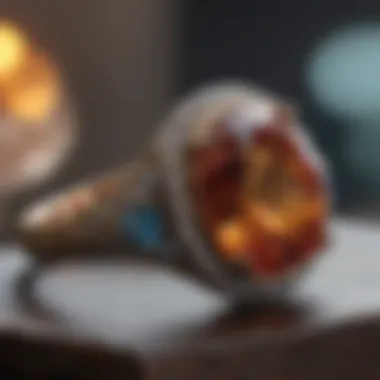
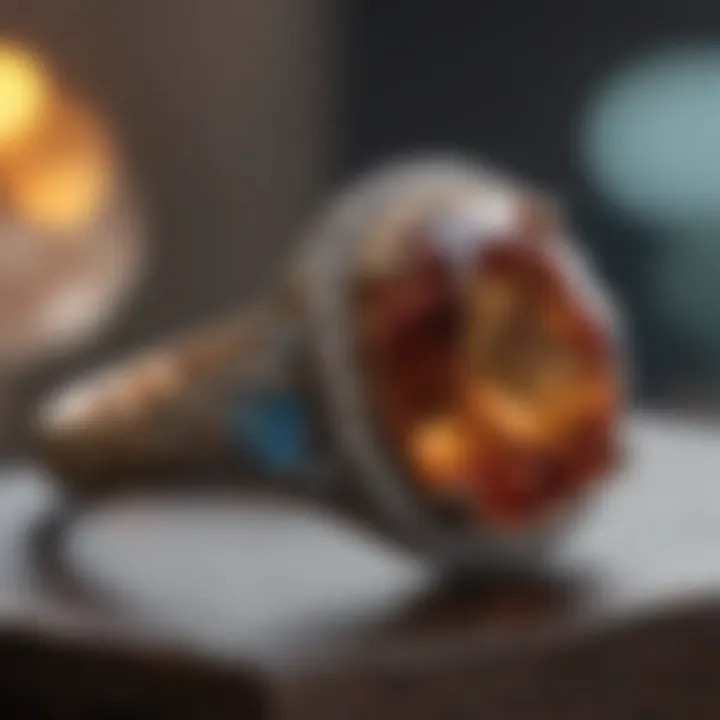
In considering these cultural significances associated with ring sizes, it’s clear that resizing is a nuanced process, requiring both technical skill and cultural sensitivity. This focus beyond just aesthetics helps reinforce the importance of understanding the persona behind the jewelry.
Current Trends in Ring Size Alteration
Ring size alteration has come a long way, evolving to meet both consumer needs and advancements in technology. Understanding current trends in this area is valuable for not just jewelers, but also for customers who seek bespoke experiences in their jewelry choices. The focus on resizing is not merely about making a ring fit; it’s about ensuring that each alteration maintains the integrity of the piece while catering to personal style and comfort.
Market Demand Analysis
In today’s jewelry market, there's a noticeable increase in demand for customized and resized rings. Consumers are no longer content with a ‘one-size-fits-all’ approach. Instead, they are seeking rings that resonate with their individual stories and identities. This trend is particularly evident in categories like engagement rings and family heirlooms. For instance:
- Customization: People want the rings to reflect their unique personalities. This drives jewelers towards offering alterations that cater to specific desires, such as altering the width or changing the stone settings.
- Function over Form: Practical considerations now play a significant role in purchasing decisions. Customers frequently inquire about resizing options before making their purchases, highlighting a priority on comfort alongside aesthetic.
- Sustainability: Eco-conscious customers are leaning towards resizing existing rings instead of buying new ones. This trend aligns well with a broader push for environmental responsibility in all industries, including jewelry.
Understanding these demands allows professionals to tailor their services, ensuring they not only meet but exceed customer expectations.
Innovations in Jewelry Design
With technology constantly revolutionizing various sectors, the jewelry industry is not left behind. Innovations in jewelry design related to ring resizing present exciting possibilities.
- Advanced Measuring Tools: Digital tools and apps that allow a precise measurement of ring sizes have emerged. Such technology helps jewelers offer more accurate resizing that minimizes the chances of misfit.
- 3D Printing: This has become a game-changer in creating custom ring designs or even trying out alterations before physically resizing the ring. Customers can visualize how a ring might look and fit, leading to higher satisfaction rates.
- Smart Rings: Wearable technology is catching on, leading to designs that can be adjusted via tech features. While this might not fit traditional resizing practices, it indicates a shift in consumer expectations towards utility and adaptability.
"The fusion of tradition with technology is paving the way for a smarter, more customizable jewelry experience."
Staying informed about these current trends proves to be advantageous for both market players and consumers. Adapting to these changes not only showcases a brand's ability to innovate but also deepens customer loyalty by aligning products and services with contemporary expectations.
Customer Expectations for Resizing Services
In the world of jewelry, the act of resizing rings often presents itself as more than just a technical adjustment. It brings with it an array of customer expectations that touch on several pivotal elements. When customers walk into a jeweler's shop looking for resizing services, they generally have certain hopes, many of which hinge on their emotional attachment to the piece and their desire for seamless craftsmanship.
Transparency in Resizing Process
One of the foremost expectations customers have is transparency regarding the resizing process. Shoppers want to know what goes on behind the scenes when they bring in a cherished ring for adjustment. This expectation arises not only from a desire for knowledge but also from a sense of trust in the jeweler's abilities. When jewelers are open about the methods used, the time frames involved, and the potential risks during resizing, it creates a deeper connection with the customer.
For example, if a customer learns that their intricate engagement ring needs a special technique to maintain its design, they’re likely to appreciate that information. Providing detailed explanations can make clients feel valued and secured. It’s vital for jewelers to outline:
- The type of resizing method employed (stretching, shrinking, adding, or removing material).
- Estimated time for the resizing to be completed.
- Costs involved, detailing how much each step contributes to the total price.
"A well-informed customer is often a satisfied customer."
This saying rings true in the jewelry industry; by communicating clearly, jewelers can manage expectations and build loyalty.
Quality Assurance in Resizing
Quality assurance remains another cornerstone of customer expectations in ring resizing. When people part with a beloved piece of jewelry, they often seek the assurance that it will return to them in as good, if not better, a condition. Achieving that means taking extra steps to ensure every resizing job upholds high standards of craftsmanship.
Jewelers should strive to offer:
- Evaluation of the Ring: Before any work begins, a thorough examination can reveal potential issues that may affect quality post-resizing.
- Use of Quality Materials: If a portion of the ring requires replacement or repair, sourcing high-quality materials can significantly affect the final product's look and integrity.
- Final Inspections: Before returning the ring to customers, jewelers should conduct a detailed inspection to guarantee that everything meets their standards.
By emphasizing quality assurance, jewelers not only fulfill customer expectations but also cement their reputation in the industry, potentially leading to referrals from satisfied clients. In summary, addressing these customer expectations with diligence can enhance both the customer experience and the jeweler's standing in this competitive field.
Epilogue and Future Perspectives
As the world of jewelry continues to unfold, the significance of ring size alteration looms large for enthusiasts, designers, and collectors alike. This not only pertains to physical alterations but also touches on emotional resonance and cultural implications. The art of resizing rings is a palpable blend of technical skill and delicate understanding of a customer’s sentiments.
Summarizing Key Insights
The techniques discussed throughout the article provide a solid framework for appreciating the complexity behind resizing rings. Techniques such as stretching, shrinking, or adding and removing materials offer various pathways to achieve the desired fit. Importantly, material considerations—particularly the interplay between different metals and gemstones—illustrate the necessary precautions jewelers must exercise.
Furthermore, the psychological aspects demonstrate the personal connections people have to their rings, whether tied to love, milestones, or unique identities. Jewelers must not only focus on the metal and stone but also factor in these intricate emotions when offering resizing services. In sum, careful attention to both craft and sentiment creates an enduring bond between the customer and their jewelry.
The Future of Ring Size Alteration
The resizing landscape is continually evolving, reflecting broader trends in fashion and consumer behavior. As demand increases for personalized and bespoke jewelry experiences, jewelers may need to innovate to meet client expectations. One important trend is the rising demand for transparency in the resizing process. Customers today want to know how their beloved piece will be altered, and what that means for the integrity of its design.
Looking ahead, jewelers should also embrace advancements in technology. Tools such as 3D printing for material additions or digital modeling to visualize alterations can transform traditional resizing into an experience that feels almost magical.
In addition to technology, a growing emphasis on sustainability in materials presents another frontier for ring size alteration. As consumers grow more conscious of the environmental footprint of their purchases, jewelers might need to explore embellishment techniques using ethically sourced or recycled materials.
Adapting to these changes means that jewelers must not only tune into evolving consumer preferences but also cultivate a deeper understanding of the cultural and emotional layers that influence ring size decisions.



